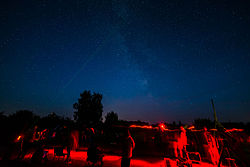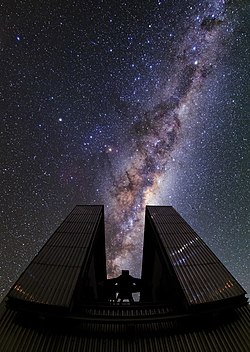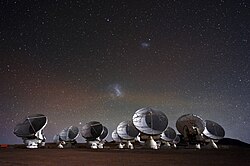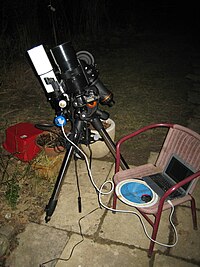Observational astronomy


Observational astronomyis a division ofastronomythat is concerned with recordingdataabout theobservable universe,in contrast withtheoretical astronomy,which is mainly concerned with calculating the measurable implications ofphysical models.It is the practice and study ofobservingcelestial objectswith the use oftelescopesand other astronomical instruments.
As ascience,the study of astronomy is somewhat hindered in that directexperimentswith the properties of the distantuniverseare not possible. However, this is partly compensated by the fact that astronomers have a vast number of visible examples of stellar phenomena that can be examined. This allows for observational data to be plotted on graphs, and general trends recorded. Nearby examples of specific phenomena, such asvariable stars,can then be used to infer the behavior of more distant representatives. Those distant yardsticks can then be employed to measure other phenomena in that neighborhood, including the distance to agalaxy.
Galileo Galileiturned atelescopeto the heavens and recorded what he saw. Since that time, observational astronomy has made steady advances with each improvement in telescope technology.
Subdivisions of observational Astronomy[edit]


A traditional division of observational astronomy is based on the region of theelectromagnetic spectrumobserved:
- Radio astronomydetectsradiationof millimetre to decametre wavelength. The receivers are similar to those used inradiobroadcast transmission but much more sensitive. See alsoRadio telescopes.
- Infrared astronomydeals with the detection and analysis ofinfrared radiation(this typically refers to wavelengths longer than the detection limit of silicon solid-state detectors, about 1 μm wavelength). The most common tool is thereflecting telescope,but with a detector sensitive to infrared wavelengths. Space telescopes are used at certain wavelengths where the atmosphere is opaque, or to eliminate noise (thermal radiation from the atmosphere).
- Optical astronomyis the part of astronomy that usesoptical instruments(mirrors, lenses, and solid-state detectors) to observelightfrom near-infraredto near-ultravioletwavelengths.Visible-light astronomy,usingwavelengthsdetectable with the human eyes (about 400–700 nm), falls in the middle ofthis spectrum.
- High-energy astronomyincludesX-ray astronomy,gamma-ray astronomy,and extremeUV astronomy.
- Occultation astronomyis the observation of the instant one celestial object occults or eclipses another. Multi-chordasteroid occultation observations measure the profile of the asteroid to the kilometre level.[1]
Methods[edit]
In addition to using electromagnetic radiation, modern astrophysicists can also make observations usingneutrinos,cosmic raysorgravitational waves.Observing a source using multiple methods is known asmulti-messenger astronomy.

Optical and radio astronomy can be performed with ground-based observatories, because the atmosphere is relatively transparent at the wavelengths being detected. Observatories are usually located at high altitudes so as to minimise the absorption and distortion caused by the Earth's atmosphere. Some wavelengths of infrared light are heavily absorbed bywater vapor,so many infrared observatories are located in dry places at high altitude, or in space.
The atmosphere is opaque at the wavelengths used by X-ray astronomy, gamma-ray astronomy, UV astronomy and (except for a few wavelength "windows" )far infrared astronomy,so observations must be carried out mostly fromballoonsor space observatories. Powerful gamma rays can, however be detected by the largeair showersthey produce, and the study of cosmic rays is a rapidly expanding branch of astronomy.
Important factors[edit]
For much of the history of observational astronomy, almost all observation was performed in the visual spectrum withoptical telescopes.While the Earth's atmosphere is relatively transparent in this portion of theelectromagnetic spectrum,most telescope work is still dependent onseeingconditions and air transparency, and is generally restricted to the night time. The seeing conditions depend on the turbulence and thermal variations in the air. Locations that are frequently cloudy or suffer from atmospheric turbulence limit the resolution of observations. Likewise the presence of the fullMooncan brighten up the sky with scattered light, hindering observation of faint objects.
For observation purposes, the optimal location for an optical telescope is undoubtedly inouter space.There the telescope can make observations without being affected by theatmosphere.However, at present it remains costly to lift telescopes intoorbit.Thus the next best locations are certain mountain peaks that have a high number of cloudless days and generally possess good atmospheric conditions (with goodseeingconditions). The peaks of the islands ofMauna Kea, HawaiiandLa Palmapossess these properties, as to a lesser extent do inland sites such asLlano de Chajnantor,Paranal,Cerro TololoandLa SillainChile.These observatory locations have attracted an assemblage of powerful telescopes, totalling many billion US dollars of investment.
The darkness of the night sky is an important factor in optical astronomy. With the size of cities and human populated areas ever expanding, the amount of artificial light at night has also increased. These artificial lights produce a diffuse background illumination that makes observation of faint astronomical features very difficult without special filters. In a few locations such as the state ofArizonaand in theUnited Kingdom,this has led to campaigns for the reduction oflight pollution.The use of hoods around street lights not only improves the amount of light directed toward the ground, but also helps reduce the light directed toward the sky.
Atmospheric effects (astronomical seeing) can severely hinder theresolutionof a telescope. Without some means of correcting for the blurring effect of the shifting atmosphere, telescopes larger than about 15–20 cm inaperturecan not achieve their theoretical resolution at visible wavelengths. As a result, the primary benefit of using very large telescopes has been the improved light-gathering capability, allowing very faint magnitudes to be observed. However the resolution handicap has begun to be overcome byadaptive optics,speckle imagingandinterferometric imaging,as well as the use ofspace telescopes.
Measuring results[edit]
Astronomers have a number of observational tools that they can use to make measurements of the heavens. For objects that are relatively close to the Sun and Earth, direct and very preciseposition measurementscan be made against a more distant (and thereby nearly stationary) background. Early observations of this nature were used to develop very precise orbital models of the various planets, and to determine their respective masses and gravitationalperturbations.Such measurements led to the discovery of the planetsUranus,Neptune,and (indirectly)Pluto.They also resulted in an erroneous assumption of a fictional planetVulcanwithin the orbit ofMercury(but the explanation of theprecessionof Mercury's orbit byEinsteinis considered one of the triumphs of hisgeneral relativitytheory).
Developments and diversity[edit]

In addition to examination of the universe in the optical spectrum, astronomers have increasingly been able to acquire information in other portions of the electromagnetic spectrum. The earliest such non-optical measurements were made of the thermal properties of theSun.Instruments employed during a solar eclipse could be used to measure the radiation from thecorona.

Radio astronomy[edit]
With the discovery ofradiowaves,radio astronomybegan to emerge as a new discipline in astronomy. The long wavelengths of radio waves required much larger collecting dishes in order to make images with good resolution, and later led to the development of the multi-dishinterferometerfor making high-resolutionaperture synthesisradio images (or "radio maps" ). The development of the microwave horn receiver led to the discovery of themicrowave background radiationassociated with theBig Bang.[4]
Radio astronomy has continued to expand its capabilities, even usingradio astronomy satellitesto produce interferometers with baselines much larger than the size of the Earth. However, the ever-expanding use of the radio spectrum for other uses is gradually drowning out the faint radio signals from the stars. For this reason, in the future radio astronomy might be performed from shielded locations, such as thefar sideof theMoon.
Late 20th-century developments[edit]
The last part of the twentieth century saw rapid technological advances in astronomical instrumentation. Optical telescopes were growing ever larger, and employingadaptive opticsto partly negate atmospheric blurring. New telescopes were launched into space, and began observing the universe in theinfrared,ultraviolet,x-ray,andgamma rayparts of the electromagnetic spectrum, as well as observingcosmic rays.Interferometer arrays produced the first extremely high-resolution images usingaperture synthesisat radio, infrared and optical wavelengths. Orbiting instruments such as theHubble Space Telescopeproduced rapid advances in astronomical knowledge, acting as the workhorse for visible-light observations of faint objects. New space instruments under development are expected to directly observe planets around other stars, perhaps even some Earth-like worlds.
In addition to telescopes, astronomers have begun using other instruments to make observations.
Other instruments[edit]
Neutrino astronomyis the branch of astronomy that observes astronomical objects withneutrino detectorsin special observatories, usually huge underground tanks.Nuclear reactionsin stars andsupernovaexplosions produce very large numbers ofneutrinos,very few of which may be detected by aneutrino telescope.Neutrino astronomy is motivated by the possibility of observing processes that are inaccessible tooptical telescopes,such as theSun's core.
Gravitational wavedetectors are being designed that may capture events such as collisions of massive objects such asneutron starsorblack holes.[5]
Roboticspacecraftare also being increasingly used to make highly detailed observations ofplanetswithin theSolar System,so that the field ofplanetary sciencenow has significant cross-over with the disciplines ofgeologyandmeteorology.
Observation tools[edit]


Telescopes[edit]

The key instrument of nearly all modern observational astronomy is thetelescope.This serves the dual purposes of gathering more light so that very faint objects can be observed, and magnifying the image so that small and distant objects can be observed. Optical astronomy requires telescopes that use optical components of great precision. Typical requirements for grinding and polishing a curved mirror, for example, require the surface to be within a fraction of a wavelength of light of a particularconicshape. Many modern "telescopes" actually consist of arrays of telescopes working together to provide higher resolution throughaperture synthesis.
Large telescopes are housed in domes, both to protect them from the weather and to stabilize the environmental conditions. For example, if the temperature is different from one side of the telescope to the other, the shape of the structure changes, due tothermal expansionpushing optical elements out of position. This can affect the image. For this reason, the domes are usually bright white (titanium dioxide) or unpainted metal. Domes are often opened around sunset, long before observing can begin, so that air can circulate and bring the entire telescope to the same temperature as the surroundings. To prevent wind-buffet or other vibrations affecting observations, it is standard practice to mount the telescope on a concrete pier whose foundations are entirely separate from those of the surrounding dome and building.
To do almost any scientific work requires that telescopes track objects as they wheel across the visible sky. In other words, they must smoothly compensate for the rotation of the Earth. Until the advent ofcomputercontrolled drive mechanisms, the standard solution was some form ofequatorial mount,and for small telescopes this is still the norm. However, this is a structurally poor design and becomes more and more cumbersome as the diameter and weight of the telescope increases. The world's largest equatorial mounted telescope is the 200 inch (5.1 m)Hale Telescope,whereas recent 8–10 m telescopes use the structurally betteraltazimuth mount,and are actually physicallysmallerthan the Hale, despite the larger mirrors. As of 2006, there are design projects underway for gigantic alt-az telescopes: the Thirty Metre Telescope[1],and the 100 m diameterOverwhelmingly Large Telescope.[7]
Amateur astronomers use such instruments as theNewtonian reflector,theRefractorand the increasingly popularMaksutov telescope.
Photography[edit]
Thephotographhas served a critical role in observational astronomy for over a century, but in the last 30 years it has been largely replaced for imaging applications by digital sensors such asCCDsandCMOSchips. Specialist areas of astronomy such as photometry and interferometry have utilised electronic detectors for a much longer period of time.Astrophotographyuses specialisedphotographic film(or usually a glass plate coated with photographicemulsion), but there are a number of drawbacks, particularly a lowquantum efficiency,of the order of 3%, whereas CCDs can be tuned for a QE >90% in a narrow band. Almost all modern telescope instruments are electronic arrays, and older telescopes have been either been retrofitted with these instruments or closed down. Glass plates are still used in some applications, such as surveying,[citation needed]because the resolution possible with a chemical film is much higher than any electronic detector yet constructed.
Advantages[edit]
Prior to the invention of photography, all astronomy was done with the naked eye. However, even before films became sensitive enough, scientific astronomy moved entirely to film, because of the overwhelming advantages:
- The human eye discards what it sees from split-second to split-second, but photographic film gathers more and more light for as long as the shutter is open.
- The resulting image is permanent, so many astronomers can use the same data.
- It is possible to see objects as they change over time (SN 1987Ais a spectacular example).
Blink comparator[edit]
Theblink comparatoris an instrument that is used to compare two nearly identical photographs made of the same section of sky at different points in time. The comparator alternates illumination of the two plates, and any changes are revealed by blinking points or streaks. This instrument has been used to findasteroids,comets,andvariable stars.

Micrometer[edit]
The position or cross-wiremicrometeris an implement that has been used to measuredouble stars.This consists of a pair of fine, movable lines that can be moved together or apart. The telescope lens is lined up on the pair and oriented using position wires that lie at right angles to the star separation. The movable wires are then adjusted to match the two star positions. The separation of the stars is then read off the instrument, and their true separation determined based on the magnification of the instrument.
Spectrograph[edit]
A vital instrument of observational astronomy is thespectrograph.The absorption of specific wavelengths of light by elements allows specific properties of distant bodies to be observed. This capability has resulted in the discovery of the element ofheliumin the Sun'semission spectrum,and has allowed astronomers to determine a great deal of information concerning distant stars, galaxies, and other celestial bodies.Doppler shift(particularly "redshift") of spectra can also be used to determine the radial motion or distance with respect to theEarth.
Early spectrographs employed banks ofprismsthat split light into a broad spectrum. Later thegrating spectrographwas developed, which reduced the amount of light loss compared to prisms and provided higher spectral resolution. The spectrum can be photographed in a long exposure, allowing the spectrum of faint objects (such as distant galaxies) to be measured.
Stellar photometry came into use in 1861 as a means of measuringstellar colors.This technique measured the magnitude of a star at specific frequency ranges, allowing a determination of the overall color, and thereforetemperatureof a star. By 1951 an internationally standardized system of UBV-magnitudes(Ultraviolet-Blue-Visual) was adopted.
Photoelectric photometry[edit]
Photoelectricphotometryusing theCCDis now frequently used to make observations through a telescope. These sensitive instruments can record the image nearly down to the level of individualphotons,and can be designed to view in parts of the spectrum that are invisible to the eye. The ability to record the arrival of small numbers of photons over a period of time can allow a degree of computer correction for atmospheric effects, sharpening up the image. Multiple digital images can also be combined to further enhance the image, often known as "stacking". When combined with theadaptive opticstechnology, image quality can approach the theoretical resolution capability of the telescope.
Filtersare used to view an object at particular frequencies or frequency ranges.Multilayer filmfilters can provide very precise control of the frequencies transmitted and blocked, so that, for example, objects can be viewed at a particular frequency emitted only by excitedhydrogenatoms. Filters can also be used to partially compensate for the effects oflight pollutionby blocking out unwanted light.Polarization filterscan also be used to determine if a source is emitting polarized light, and the orientation of the polarization.
Observing[edit]

Astronomers observe a wide range of astronomical sources, including high-redshift galaxies,AGNs,theafterglow from the Big Bangand many different types of stars and protostars.
A variety of data can be observed for each object. The positioncoordinateslocate the object on the sky using the techniques ofspherical astronomy,and themagnitudedetermines its brightness as seen from theEarth.The relative brightness in different parts of the spectrum yields information about thetemperatureand physics of the object. Photographs of the spectra allow the chemistry of the object to be examined.
Parallaxshifts of a star against the background can be used to determine the distance, out to a limit imposed by the resolution of the instrument. Theradial velocityof the star and changes in its position over time (proper motion) can be used to measure its velocity relative to the Sun. Variations in the brightness of the star give evidence of instabilities in the star's atmosphere, or else the presence of an occulting companion. The orbits of binary stars can be used to measure the relative masses of each companion, or the total mass of the system. Spectroscopic binaries can be found by observingdoppler shiftsin the spectrum of the star and its close companion.
Stars of identical masses that formed at the same time and under similar conditions typically have nearly identical observed properties. Observing a mass of closely associated stars, such as in aglobular cluster,allows data to be assembled about the distribution of stellar types. These tables can then be used to infer the age of the association.
For distantgalaxiesandAGNsobservations are made of the overall shape and properties of the galaxy, as well as thegroupingswhere they are found. Observations of certain types ofvariable starsandsupernovaeof knownluminosity,calledstandard candles,in other galaxies allows the inference of the distance to the host galaxy. The expansion of space causes the spectra of these galaxies to be shifted, depending on the distance, and modified by theDoppler effectof the galaxy's radial velocity. Both the size of the galaxy and itsredshiftcan be used to infer something about the distance of the galaxy. Observations of large numbers of galaxies are referred to asredshift surveys,and are used to model the evolution of galaxy forms.
See also[edit]
- Lunar observation
- Observational study
- Observatory
- Space telescope
- Timeline of telescopes, observatories, and observing technology
Related lists[edit]
References[edit]
- ^Schindler, K.; Wolf, J.; Bardecker, J.; Olsen, A.; Müller, T.; Kiss, C.; Ortiz, J. L.; Braga-Ribas, F.; Camargo, J. I. B.; Herald, D.; Krabbe, A. (2017). "Results from a triple chord stellar occultation and far-infrared photometry of the trans-Neptunian object (229762) 2007 UK126".Astronomy & Astrophysics.600:A12.arXiv:1611.02798.Bibcode:2017A&A...600A..12S.doi:10.1051/0004-6361/201628620.S2CID48357636.
- ^"La Silla Poses for an Ultra HD Shoot".ESO Picture of the Week.Retrieved16 April2014.
- ^"Under the Spell of the Magellanic Clouds".ESO Picture of the Week.Retrieved17 April2013.
- ^Dicke, R. H.; Peebles, P. J. E.; Roll, P. G.; Wilkinson, D. T. (July 1965). "Cosmic Black-Body Radiation".The Astrophysical Journal.142:414–419.Bibcode:1965ApJ...142..414D.doi:10.1086/148306.ISSN0004-637X.
- ^"Planning for a bright tomorrow: Prospects for gravitational-wave astronomy with Advanced LIGO and Advanced Virgo".LIGO Scientific Collaboration.Retrieved31 December2015.
- ^The Quito Astronomical Observatory is managed by National Polytechnic School, EPN, official website.
- ^The ESO 100-m OWL optical telescope concept
- ^"The Martian-like Landscape of La Silla".Retrieved16 November2015.
External links[edit]
- Archives and iconographyfrom 17th century preserved by theParis Observatorylibrary
 Media related toObservational astronomyat Wikimedia Commons
Media related toObservational astronomyat Wikimedia Commons
